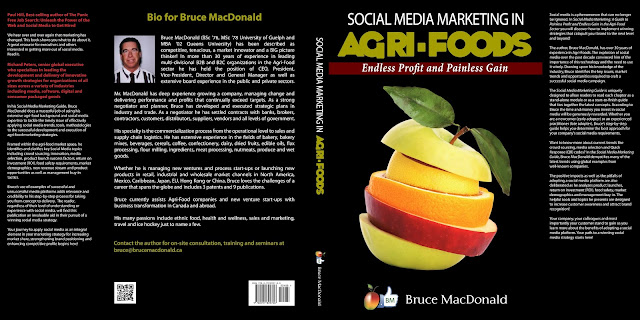FOOD SUSTAINABILITY: Part 3 - The GM Controversy
The book is available on Amazon and Kindle for $4.99 USD. Visit amazon/Kindle to order now:
http://www.amazon.ca/Social-Media-Marketing-Agri-Foods-ebook/dp/B00C42OB3E/ref=sr_1_1?s=digital-text&ie=UTF8&qid=1364756966&sr=1-1
Thanks for taking the time
Box 1. GM controversy |
| There is controversy over whether GM can increase crop yields while conserving resources. GM crops in commercial cultivation mainly express two traits — herbicide tolerance and pest resistance. These traits promise higher yields with lower pesticide use. However, their impacts have been variable and depend on a range of external factors. For example, India, China and South Africa found that socioeconomic, agronomic and institutional factors have had a big impact on farmers' experiences withBt cotton technology. [14] In Africa, an analysis of 11 improved varieties showed that success depended not only on new technologies, but also on partnerships between researchers and local farmers at every stage of the innovation process. [15] |
There were social concerns, too. Farmers with plenty of land, irrigation and credit benefited the most, while resource-constrained farmers, smallholders, or those farming marginal land benefit ted largely indirectly — as a result of lower food costs and an increase in farm employment in favorable areas. There were also unintended nutritional outcomes of the Green Revolution. For example, intensive cultivation of high-yielding staples led to less dietary diversity and may have affected the availability and use of nutrient-dense 'wild' foods. [12]
New developments in agricultural S&T
Since the 1990s, a second 'wave' of technology development has sought new crop varieties through biotechnology, with controversy focusing on genetically modified (GM) crops (Box 1). Some say GM crops are now "being taken up faster than any other agricultural technology since the plough 8,000 years ago, and are presently being used by 16 million farmers". [13]
S&T advances have been based on molecular genetics, specifically recombinant DNA technology. This lets scientists combine genetic material from multiple sources (e.g. from two different species), creating combinations not otherwise found in nature. The first GM crop to be released for commercial cultivation was 'Roundup Ready' soybean in 1996, which resists the herbicide glyphosate, allowing farmers to apply the herbicide without harming soy crops. Since then, recombinant DNA has been used to develop 'golden rice' (a variety fortified with the vitamin-A precursor beta-carotene) and crops resistant to herbicides, insects and viruses.
Unlike the Green Revolution, which was funded and supported by public-sector bodies, the 'gene revolution' is primarily driven by a private and global research system where new technologies find their way to developing countries through the market. [10] There is tremendous private sector funding support for transgenic crops. As of 2005, for example, the top ten multinational bioscience corporations collectively spent nearly US$3 billion per year on agricultural R&D — ten times more than that spent annually by the 15 CGIAR research centres, which together constitute the largest international public sector consortium supplier of agricultural technologies. [10]
S&T advances have been based on molecular genetics, specifically recombinant DNA technology. This lets scientists combine genetic material from multiple sources (e.g. from two different species), creating combinations not otherwise found in nature. The first GM crop to be released for commercial cultivation was 'Roundup Ready' soybean in 1996, which resists the herbicide glyphosate, allowing farmers to apply the herbicide without harming soy crops. Since then, recombinant DNA has been used to develop 'golden rice' (a variety fortified with the vitamin-A precursor beta-carotene) and crops resistant to herbicides, insects and viruses.
Unlike the Green Revolution, which was funded and supported by public-sector bodies, the 'gene revolution' is primarily driven by a private and global research system where new technologies find their way to developing countries through the market. [10] There is tremendous private sector funding support for transgenic crops. As of 2005, for example, the top ten multinational bioscience corporations collectively spent nearly US$3 billion per year on agricultural R&D — ten times more than that spent annually by the 15 CGIAR research centres, which together constitute the largest international public sector consortium supplier of agricultural technologies. [10]
Better varieties for smallholders
Smallholders deliver most of the food produced in developing nations, and their need for more productive, pest-tolerant and nutritious varieties is increasingly recognised. Several initiatives are seeking to develop and disseminate improved varieties of indigenous or traditional crops that have so far been neglected by privately funded biotechnology research.
For example, the African Orphan Crop Consortium (AOCC) aims to map and analyse the genomes of 100 so-called 'orphan' crops, selected by African scientists, which have so far been neglected as they were not economically important on the global market. The AOCC plans to make its data and findings freely accessible to researchers and breeders in Africa and elsewhere.
For example, the African Orphan Crop Consortium (AOCC) aims to map and analyse the genomes of 100 so-called 'orphan' crops, selected by African scientists, which have so far been neglected as they were not economically important on the global market. The AOCC plans to make its data and findings freely accessible to researchers and breeders in Africa and elsewhere.
- Check out my new e-book entitled: "Social Media Marketing in Agri-Foods: Endless Profit and Painless Gain"
The book is available on Amazon and Kindle for $4.99 USD. Visit amazon/Kindle to order now:
http://www.amazon.ca/Social-Media-Marketing-Agri-Foods-ebook/dp/B00C42OB3E/ref=sr_1_1?s=digital-text&ie=UTF8&qid=1364756966&sr=1-1
Thanks for taking the time


No comments:
Post a Comment